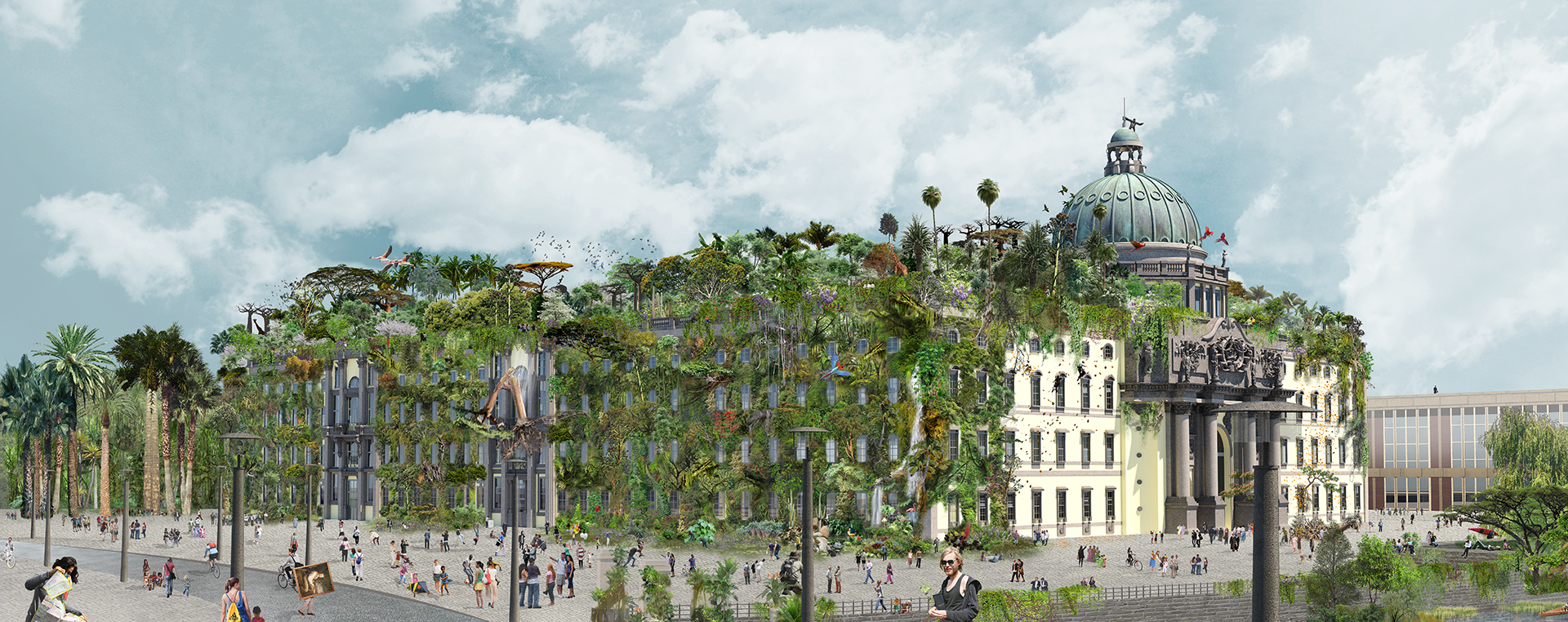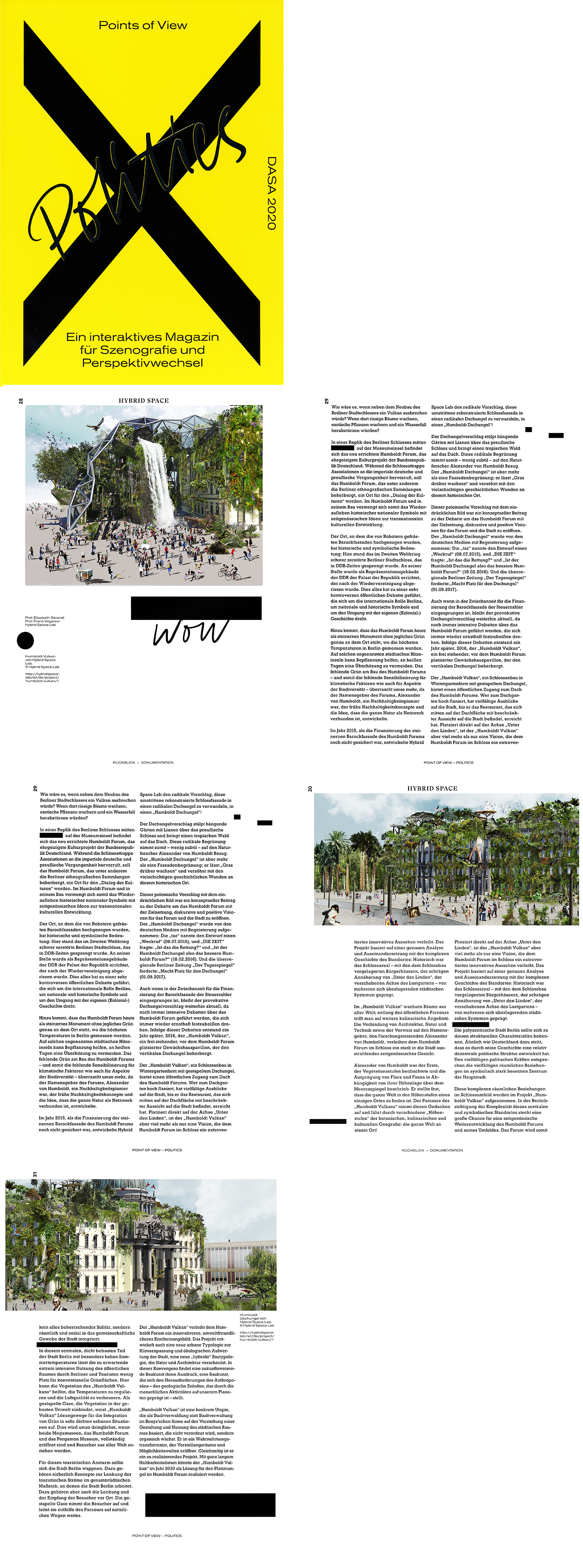What would it be like if a volcano erupted next to the new Berlin City Palace?
If huge trees grew there, exotic plants proliferated and a waterfall cascaded down?
Publication Future Heritage @ Points of View, DASA Museum, Dortmund, Germany 1 March 2020
Humboldt
Forum
The newly built Humboldt Forum, Germany’s most ambitious cultural project, is located in a replica of the Berlin Palace in the centre of Museum Island. While the replica palace evokes associations with the imperial German and Prussian past, the Humboldt Forum, which houses the Berlin ethnographic collections among other things, is intended to be a place for the ‘dialogue of cultures. The Humboldt Forum and its building thus combine the revival of historical national symbols with contemporary ideas on transnational cultural development.
The site where the baroque façades milled by robots were raised has historical and symbolic significance: this was the location of the Berlin City Palace, which was badly destroyed in the Second World War and blown up during the GDR era. In its place, the Palace of the Republic was erected as a representative building of the GDR, which was demolished after reunification. All of this has led to a highly controversial public debate centred around Berlin’s international role, national and historical symbols and how the city deals with its own (colonial) history.
What’s more, the Humboldt Forum is now a stone monument without any greenery at the exact location where the highest temperatures in Berlin are measured. On such so-called urban heat islands, planting can help to prevent overheating on hot days. The lack of greenery on the Humboldt Forum building – and thus the lack of sensitisation to climatic factors and aspects of biodiversity – is all the more surprising given that the man who gave the Forum its name, Alexander von Humboldt, was a sustainability pioneer who developed early sustainability concepts and the idea that all of nature is connected as a network.

In 2015, when funding for the Humboldt Forum’s stone baroque façade had not yet been secured, Hybrid Space Lab developed the radical proposal to transform this controversial reconstructed palace façade into a jungle, a ‘Humboldt Jungle’!
The jungle proposal would cover the Prussian palace with hanging gardens of lianas and create a tropical forest on the roof. This radical greening thus refers – not very subtly – to the natural scientist Alexander von Humboldt. However, the ‘Humboldt Jungle’ is more than just a green façade; it allows ‘grass to grow over it’ and reconciles the complex historical wounds at this historic site.
This polemical proposal with the impressive image was a conceptual contribution to the debate about the Humboldt Forum with the aim of opening up discursive and positive visions for the Forum and the city. The ‘Humboldt Jungle’ was enthusiastically received by the German media: ‘taz’ called the design a ‘wake-up call’ (08/07/2015), and ‘DIE ZEIT’ asked, ‘Is this salvation?’ and ‘So is the Humboldt Jungle the better Humboldt Forum?’ (18.02.2016). And the national Berlin newspaper ‘Der Tagesspiegel’ demanded: ‘Make way for the jungle’ (1 September 2017).
Even though taxpayers have since stepped in to finance the baroque façade, the provocative jungle proposal remains topical, as intense debates about the Humboldt Forum continue to rage and threaten to become seriously entrenched. As a result of these debates, a year later, in 2016, the ‘Humboldt Volcano’ was created, a free-standing greenhouse pavilion placed in front of the Humboldt Forum, which houses the vertical jungle.

The ‘Humboldt Volcano’, a palace extension in the form of a winter garden with a stacked jungle, provides public access to the roof of the Humboldt Forum. Those who stroll up to the roof garden have a variety of views of the city until they reach the restaurant, which is located in the centre of the roof area with a limited view of the city.
Trees from all over the world grow in the ‘Humboldt Volcano’ and there are other culinary offerings along the public trail. The combination of architecture, nature and technology as well as the reference to its namesake, the explorer Alexander von Humboldt, give the Humboldt Forum in the palace a contemporary face that radiates strongly into the city.
Alexander von Humboldt was the first to observe vegetation levels and describe the characteristics of flora and fauna depending on their altitude above sea level. He realised that the whole world can be found in the altitude levels of a single place. The ‘Humboldt Volcano’ trail takes up this idea and leads through various ‘altitude levels’ of botanical, culinary and cultural geography: the whole world in one place!
Placed directly on the ‘Unter den Linden’ axis, the ‘Humboldt Volcano’ is much more than just a vision that gives the Humboldt Forum in the palace an extroverted, innovative appearance. The project is based on a precise analysis and examination of the complex history of the site: historically, the palace area – with the town houses in front of the palace building, the diagonal approach of ‘Unter den Linden’, the shifted axis of the Lustgarten – was characterised by several overlapping urban systems.
The polycentric city of Berlin should acknowledge these structural characteristics. Just as Germany has developed a relatively decentralised political structure through its history. The diverse political forces correspond to the diverse spatial relationships in the symbolically strongly occupied centre of the capital.
These complex spatial relationships in the area surrounding the palace are taken up in the ‘Humboldt Volcano’ project. Taking into account the complexity of this central and symbolic location is a great opportunity for the contemporary development of the Humboldt Forum and its surroundings. The Forum will thus not be an all-dominating solitaire, but will be spatially and socially integrated into the communal fabric of the city.
In this central, densely built-up part of Berlin with particularly high summer temperatures, the expected extremely intensive use of public space by Berliners and tourists leaves little room for conventional green spaces. Here, the vegetation of the ‘Humboldt Volcano’ can help to regulate temperatures and improve air quality. As a stacked oasis that integrates vegetation into the built environment, ‘Humboldt Volcano’ offers solutions for the integration of greenery in very dense urban situations.
This will become all the more urgent when both mega-museums, the Humboldt Forum and the Pergamon Museum, are fully opened and attract visitors from all over the world. The city of Berlin should prepare itself for this onslaught of tourists. This certainly includes concepts for directing tourist flows on a city-wide scale, which the city of Berlin is working on. But this also includes guiding and welcoming visitors on site. The stacked oasis welcomes visitors and guides them along natural paths with the help of the trail.
The ‘Humboldt Volcano’ gives the Humboldt Forum a more innovative, environmentally friendly appearance. The project also develops a new urban typology for climate adaptation and ecological upgrading of the city, a new ‘hybrid’ building typology that merges nature and architecture. This convergence is the expression of a forward-looking architecture, an architecture that meets the challenges of the Anthropocene – the geological era characterised by human activity on our planet.
‘Humboldt Volcano’ is a concrete utopia that is based on the idea of a design and utilisation of urban space that is not prescribed but grows organically, as urban forestation instead of urban administration in the Beuysian sense. It is a transformer of perception that opens up imaginative spaces and worlds of possibility. At the same time, it is a project to be realised. With a very long shelf life, the ‘Humboldt Volcano’ could be realised in 2030 as a solution to the lack of space in the Humboldt Forum.
related PROJECTS
related PRESS
